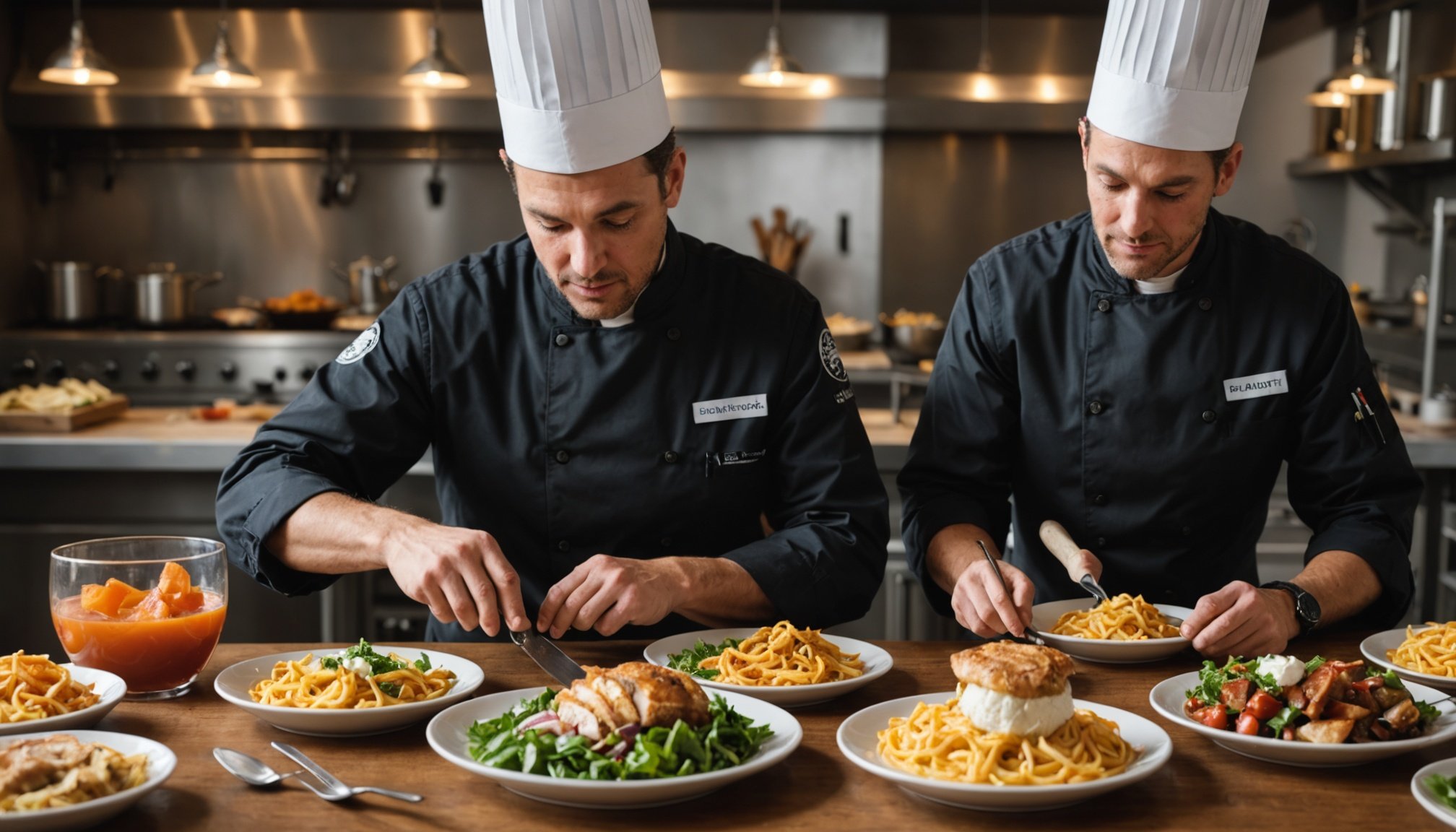Current Culinary Trends Amidst Social and Economic Uncertainties
The culinary world is being transformed by both economic impact and social changes, leading to novel culinary trends. Economic instability has notably shifted consumer preferences. People are more inclined towards budget-friendly meals, introducing trends that prioritize cost-effective ingredients without compromising taste. This has been the catalyst for innovative techniques like plant-centred dishes that offer nutrition and sustainability.
Moreover, social changes are inspiring culinary trends that highlight community and cultural connectivity. With global interactions enhanced, innovative cooking practices such as fusion cuisines are becoming increasingly popular. These creative culinary expressions not only cater to diverse palates but also promote acceptance and understanding through food.
In particular, a rise in comfort food during uncertain times shows how societal stressors can guide meal choices. People gravitate towards familiar flavours, seeking solace through these nostalgic dishes. This intersection of social and economic factors fosters a cooking environment where both tradition and innovation meet, encouraging experimentation while reflecting the collective mood.
As the food landscape continues to evolve, understanding these trends provides insights into consumer behavior. It sheds light on how the culinary world creatively adapts amid uncertainties, offering both challenges and opportunities for the food industry to innovate and grow.
Innovative Cooking Techniques for Uncertain Times
In challenging circumstances, adopting innovative cooking techniques becomes essential for adaptability and resilience. Focusing on efficient strategies like batch cooking and meal prep can greatly streamline meal planning. These methods not only save time and money but also minimize stress in the kitchen, allowing individuals to prepare multiple meals in one session. This enables the usage of ingredients judiciously across various dishes.
Batch Cooking and Meal Prep Strategies
Relying on batch cooking involves preparing large quantities of food at once and storing portions for future meals. This tactic decreases daily meal preparation time and reduces waste. Planning menus around seasonal and cost-effective ingredients is a practical start for anyone looking to embrace these strategies in times of economic uncertainty.
Creative Ingredient Substitutions
Another approach is incorporating creative ingredient substitutions. Using affordable and readily available alternatives can maintain a dish’s integrity while cutting costs. Exploring herbs, spices, and grains adds novelty to familiar recipes and invites exploration within budget constraints.
Utilizing Leftovers Effectively
Furthermore, utilizing leftovers effectively prevents food waste and encourages ingenuity. Creatively transforming yesterday’s meals into today’s delights ensures tasteful recycling of ingredients while conserving resources. Making this a habit aligns with, and supports, both financial and environmental goals. Understanding these techniques allows culinary enthusiasts to remain adaptable and resilient, combating economic and social challenges gracefully.
Sustainable Practices in Home Cooking
Incorporating sustainable practices into home cooking routines has become essential, especially during economic shifts. Adopting mindful approaches, such as prioritising local produce, can significantly reduce the environmental impact while supporting community resilience. This means choosing ingredients that are grown nearby, which conserves resources and nurtures local economies.
Ethical sourcing plays a vital role in sustainability. Being intentional about where and how food is obtained ensures that both people and the planet are respected. This includes purchasing from brands committed to fair trade principles and animal welfare.
Implementing eco-friendly practices starts with small changes. Focus on reducing food waste through meticulous meal planning and utilising every part of an ingredient. For instance, vegetable scraps can become flavourful stocks. Similarly, storing food properly extends shelf life, minimising spoilage.
Supporting community resilience extends beyond individual choices. Participating in farmer’s markets and community-supported agriculture (CSA) connects consumers with growers, facilitating reciprocal benefits. This not only fortifies local economies but also enriches the cooking experience with fresh, flavourful produce.
By integrating these sustainable methods, individuals contribute to a more ethical food system while enjoying diverse, nourishing meals, demonstrating how informed choices make a significant impact.
Consumer Behavior Shifts in the Culinary World
In today’s rapidly changing environment, we observe significant consumer trends impacting the culinary landscape. Economic pressures are reshaping food spending habits as individuals seek cost-effective and convenient solutions. The rise of home cooking highlights a preference for cooking at home, often sparked by economic need and the desire for healthier, tailored meals. This shift encourages people to become more involved in preparing their own food, providing comfort and control over ingredients used.
The demand for convenience foods is also on the rise. Meal kits and ready-to-eat options offer ease and efficiency, catering to busy schedules without compromising quality or taste. These solutions reflect a balance between homemade meals and the convenience often sought in today’s fast-paced life.
Health-conscious choices are becoming prevalent, especially during times of crisis. People are increasingly focused on nutrition, turning towards plant-based diets and nutrition-focused options. This move not only supports personal well-being but also aligns with broader sustainability goals. By opting for healthy and convenient food options, consumers are adjusting their culinary practices to suit personal and environmental needs, embracing a new wave of resilient and adaptable food behaviors.
Engaging Recipes that Promote Creativity and Resilience
In times of economic instability and social changes, embracing creative recipes allows home cooks to adapt and thrive. These recipes often rely on common pantry ingredients, offering simplicity and affordability. By creatively using what’s on hand, individuals can craft delightful meals even amidst limited supplies. Such practices foster resilience, encouraging cooks to explore new possibilities with familiar items.
Highlighting international dishes further expands culinary horizons, resonating during global uncertainties. These dishes often combine culinary innovations with accessibility, bringing diverse flavours to the kitchen. They not only nourish but also connect cooks with global cultures, promoting empathy and understanding.
Seasonal produce provides another avenue for culinary innovation. Encouraging creative adaptations of these ingredients not only ensures freshness but also enhances sustainability. Cooking with the seasons allows local flavours to shine, and it’s a chance to experiment with different textures and tastes.
Transforming traditional recipes through these creative recipes meets the need for nourishment and the joy of cooking. It reveals how the kitchen can be a place of both invention and security, where simple ingredients lead to memorable, flavourful experiences. This approach inspires a deeper connection to food, forging a path through uncertainty with resourcefulness and flair.
Expert Opinions on the Future of Culinary Practices
The evolving culinary landscape has prompted industry experts to provide valuable insights into future trends. Through interviews with chefs and food influencers, new practices such as sustainable sourcing and plant-based menus are emerging as critical components. These culinary leaders emphasise the importance of adaptability and creativity, highlighting how focusing on local ingredients fulfills both economic and environmental priorities.
Technological advancements play a pivotal role in shaping future cooking methods. Innovations such as AI-driven recipe recommendations and smart kitchen appliances are becoming integral, offering efficient and personalised culinary experiences. These technologies streamline meal preparation, adapting to individual preferences while promoting conscious consumption.
Predictions for a post-crisis culinary world suggest a continuation of many trends observed now. Experts foresee increased consumer demands for nutrition-focused options and convenience, driven by a heightened awareness of health and time constraints. This aligns with a broader shift towards sustainability and mindfulness in food choices.
As the culinary industry continues to navigate through uncertainties, these expert analyses provide a roadmap for resilience. They underscore a need to blend tradition with innovation, ensuring future culinary practices remain adaptable, sustainable, and engaging for home cooks and professionals alike.
Creative Engagement Strategies for Home Cookers
In the realm of social cooking, home cooks can tap into a wealth of online resources to enhance their culinary journey. Virtual gatherings and online cooking classes have surged in popularity, offering an accessible platform to hone skills and connect with like-minded individuals. These digital arenas empower cooks to explore diverse cuisines and techniques, enriching their repertoire.
Social media acts as a dynamic tool for culinary inspiration. Platforms such as Instagram and TikTok showcase everything from minute-long cooking hacks to elaborate recipe walkthroughs. Here, budding chefs can share their creations and glean ideas from global tastemakers, building a vibrant community that celebrates food innovation.
Community engagement initiatives highlight sustainable cooking practices, facilitating a shared responsibility towards ethical food systems. Local groups often organise events like farm-to-table dinners, which promote awareness about sourcing and seasonality. By participating, members contribute to and learn about sustainable efforts, feeding into a cycle of culinary and environmental stewardship.
To encourage exploration, users can engage with challenges or themed virtual cook-offs, spurring creativity while connecting socially. These methods embody the spirit of collaboration and continuous learning, allowing home cooks to find joy and purpose in their culinary pursuits amidst ever-changing times.







